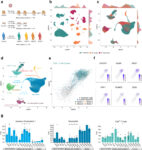
How AI is helping to bridge the research gap between animals and humans



The transfer of knowledge from animal models to humans is essential for unraveling disease mechanisms and developing precise therapeutic strategies. The high-resolution method of single-cell RNA sequencing makes it possible to reveal similarities and differences between humans and animal models at the molecular and cellular level with unprecedented accuracy. However, there are very few computer-based methods that allow detailed comparison of this valuable data.
In a recent research paper published in the journal eBioMedicine, scientists from the Institute for Medical Informatics, Statistics and Epidemiology (IMISE) and from ScaDS.AI at Leipzig University, together with the Department of Respiratory Medicine and Critical Care Medicine at Charité, present an AI model they created for COVID-19 based on neural networks. They used blood data from humans and different hamster species with moderate or severe COVID-19 and compared them at the molecular level.
“We have shown that the translational gap between animal models and human patients can be narrowed by integrating robust deep learning models in combination with biologically informed analyses. The AI systematically learns the molecular differences between the animal and the human, and can then translate the molecular patterns of the sick animal into corresponding patterns in humans, so to speak humanizing the data from the animal model,” says Dr. Holger Kirsten, scientist at the Institute for Medical Informatics, Statistics and Epidemiology (IMISE) at Leipzig University and corresponding author of the recent study.
“We were able to show that the activation of the immune system in moderate COVID-19 cases is very similar in Syrian hamsters and humans, particularly when considering monocytes,” says Dr. Geraldine Nouailles, Scientific Group Leader at the Department of Respiratory Medicine and Critical Care Medicine at Charité and also corresponding author of the study. Monocytes are precursors of macrophages, the scavenger cells of the immune system.
“On the other hand, if we want to study severe cases of disease, it is best to look at neutrophils from Roborovski hamsters,” says the scientist. “These particularly fast-reacting immune cells behave very similarly in this species of hamster and in humans.” These findings are consistent with pandemic observations gathered from human patient data.
“Such comparisons of single-cell RNA sequencing data are well suited to reveal similarities and differences at the molecular and cellular level in animals and humans that go far beyond COVID-19 research,” says Kirsten.
Nouailles sums up, saying, “The methodology we have developed allows us to better identify suitable animal models for human diseases and to determine which stages of the disease correspond to each other. This may improve the development and testing of therapeutic strategies and optimize the translation process from preclinical to clinical studies.”
In the future, the Leipzig research team plans to further develop this methodology and apply it to other animal models used to study the efficacy and safety of immunomodulatory therapies in humans. One example of this is CAR T cell therapy, a promising treatment method for certain types of cancer.
More information:
Vincent D. Friedrich et al, Neural network-assisted humanisation of COVID-19 hamster transcriptomic data reveals matching severity states in human disease, eBioMedicine (2024). DOI: 10.1016/j.ebiom.2024.105312
Citation:
How AI is helping to bridge the research gap between animals and humans (2024, September 25)
retrieved 25 September 2024
from https://medicalxpress.com/news/2024-09-ai-bridge-gap-animals-humans.html
This document is subject to copyright. Apart from any fair dealing for the purpose of private study or research, no
part may be reproduced without the written permission. The content is provided for information purposes only.